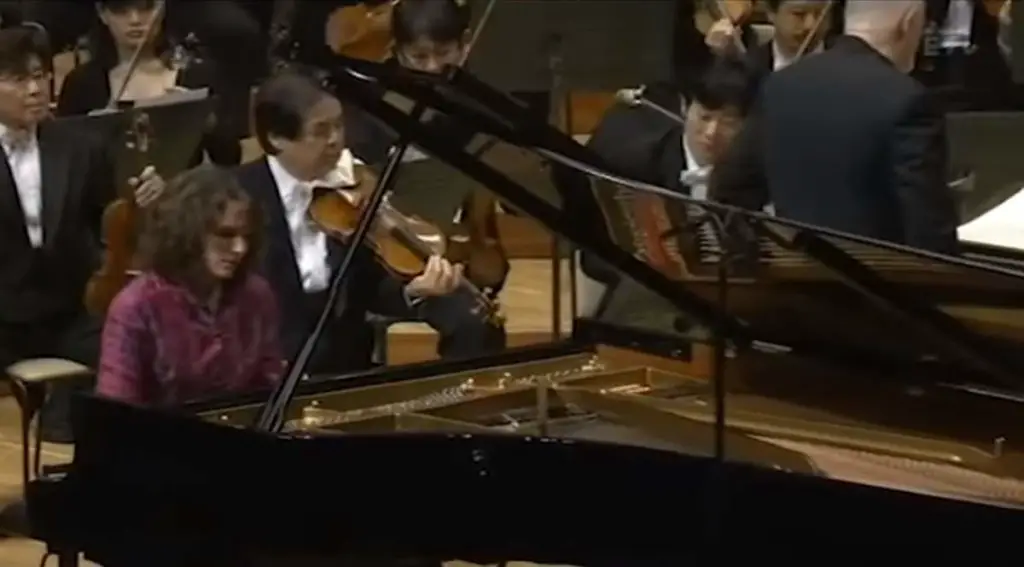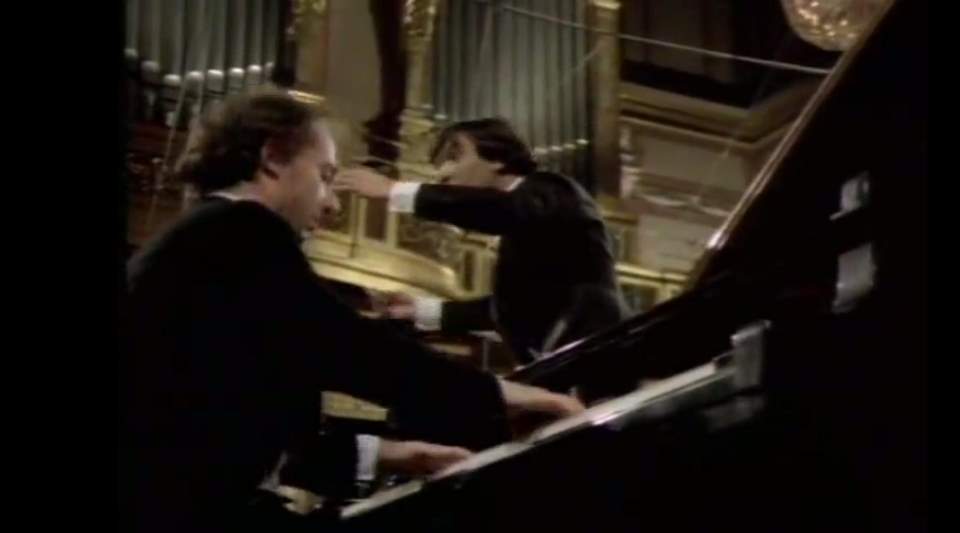Accompanied by the Warsaw Philharmonic Orchestra, the Canadian virtuoso pianist and composer Marc-André Hamelin performs Johannes Brahms’ Piano Concerto No. 2 in B-flat major, Op. 83. Conductor: Jacek Kaspszyk. This performance was recorded at the Warsaw Philharmonic Concert Hall on December 9, 2016.
Johannes Brahms’ Piano Concerto No. 2
Johannes Brahms’s Piano Concerto No. 2 in B-flat major, Op. 83, is a monumental work in the piano concerto repertoire, known for its expansive structure and technical demands. Composed over a span of three years, from 1878 to 1881, it premiered in Budapest on November 9, 1881, with Brahms himself as the soloist. This concerto stands out for its symphonic breadth, often considered more akin to a symphony with piano obbligato due to its intricate orchestration and extended length.
Brahms’s second piano concerto diverges from the typical concerto form of the time, not only in its scale but also in its structural innovations. Unlike many concertos that feature three movements, Brahms’s work is divided into four movements, adding a scherzo, which is unusual for a piano concerto. This addition contributes to the work’s substantial and complex character, allowing for a wide emotional and thematic range. The concerto opens with a lyrical horn solo, setting a serene yet majestic tone that is soon complemented by the piano’s entry. This introduction is indicative of the concerto’s overall approach, where the piano and orchestra engage in a profound dialogue rather than a display of soloistic bravura.
Technically, the concerto is demanding for the pianist, requiring not only virtuosity but also a deep understanding of its musical and structural subtleties. The piano part, rich with intricate passages and expressive depth, demands both power and sensitivity from the performer. Meanwhile, the orchestration is equally intricate, with Brahms employing the full palette of the orchestra to create lush, symphonic textures. The interplay between the soloist and the orchestra is more collaborative than competitive, reflecting Brahms’s preference for integrating the piano within the orchestral fabric rather than using it as a mere vehicle for virtuosity.
Brahms’s Piano Concerto No. 2 is celebrated for its maturity and the seamless integration of its musical ideas. It remains a favorite in concert halls around the world, revered for its emotional depth, structural complexity, and the profound conversation it weaves between the soloist and the orchestra.
Movements
1. Allegro non troppo
The first movement of Brahms’s Piano Concerto No. 2 is a masterful blend of lyricism and grandeur. Marked Allegro non troppo, it opens with a solo horn call that sets a serene and expansive tone. This opening theme, characterized by its nobility and warmth, is soon joined by the piano, which enters with a series of intricate arpeggios, establishing a dialogue between the soloist and the orchestra.
Brahms’s orchestration in this movement is notably rich and complex, employing the full range of the orchestra to create a lush, symphonic texture. The piano part is equally demanding, requiring the soloist to navigate both technically challenging passages and moments of profound expressiveness. The movement’s structure adheres to the sonata form, with a clear exposition, development, and recapitulation, yet Brahms infuses this classical framework with his unique voice, blending traditional forms with his characteristic depth and innovation.
The interaction between the piano and orchestra is central to the movement’s character. Rather than dominating the texture, the piano often engages in a conversational interplay with the orchestral instruments, highlighting Brahms’s skill in balancing the roles of soloist and ensemble. The thematic material introduced by the horn and developed by the piano and orchestra is revisited and transformed throughout the movement, creating a cohesive and evolving musical narrative.
One of the most striking features of the first movement is its dynamic range and emotional depth. Brahms juxtaposes moments of introspective lyricism with passages of powerful intensity, maintaining a sense of forward momentum and dramatic tension. This contrast is further enhanced by his use of varied orchestral colors and textures, from the intimate interplay between solo instruments to the full, majestic sound of the entire orchestra.
2. Allegro appassionato
The second movement of Brahms’s Piano Concerto No. 2, marked Allegro appassionato, serves as a striking contrast to the first movement’s grandeur. This scherzo-like movement is intense and vigorous, characterized by its dramatic and turbulent nature. It begins with a bold, forceful theme introduced by the piano, immediately setting a passionate and dynamic tone.
The piano and orchestra engage in a lively dialogue, with the piano often taking the lead in presenting the movement’s main themes. Brahms employs a variety of rhythmic and harmonic devices to create a sense of urgency and tension throughout the movement. The piano part is particularly demanding, requiring the soloist to display both technical prowess and expressive depth.
Orchestrally, Brahms makes extensive use of the full range of the ensemble to create a rich and textured soundscape. The strings, winds, and brass each contribute to the movement’s overall intensity, with Brahms skillfully balancing the solo piano against the orchestra. The interplay between the soloist and the ensemble is intricate and dynamic, with frequent shifts in mood and texture.
One of the defining features of the second movement is its structural complexity. While it adheres to a scherzo and trio form, Brahms imbues it with a level of sophistication and emotional depth that goes beyond the typical characteristics of this form. The trio section, marked by a more lyrical and serene theme, provides a brief respite from the movement’s prevailing intensity before the return of the scherzo’s dramatic material.
The movement’s conclusion is powerful and decisive, bringing the passionate and energetic character to a climactic end. The second movement of Brahms’s Piano Concerto No. 2 is a testament to his ability to combine structural rigor with expressive freedom, creating a piece that is both technically challenging and emotionally compelling.
3. Andante
The third movement of Brahms’s Piano Concerto No. 2, marked Andante, is a serene and introspective interlude, offering a stark contrast to the vigorous scherzo of the second movement. This movement is often noted for its lyrical beauty and emotional depth, characterized by its calm and reflective nature.
The movement opens with a solo cello melody, one of the most poignant and memorable themes in the concerto. This soulful, singing line sets a contemplative tone, supported by gentle orchestral accompaniment. The piano’s entry is delicate and restrained, complementing the cello’s melody rather than dominating it. This interplay between the solo cello and piano is a hallmark of the movement, showcasing Brahms’s skill in creating intimate, chamber-like textures within a concerto setting.
As the movement progresses, the piano takes on a more prominent role, presenting lyrical and expressive passages that require both technical finesse and emotional sensitivity. The orchestration remains subtle and supportive, allowing the piano to shine while maintaining a sense of balance and cohesion. Brahms’s use of harmony and dynamics enhances the movement’s tranquil and introspective mood, with moments of delicate nuance and gentle ebb and flow.
4. Allegretto grazioso-Un poco più presto
The fourth movement of Brahms’s Piano Concerto No. 2, marked Allegretto grazioso, brings the concerto to a spirited and graceful conclusion. This finale contrasts with the introspective third movement, characterized by its lively and light-hearted character.
The movement opens with a charming and dance-like theme introduced by the piano, setting an elegant and playful tone. This main theme is graceful and whimsical, showcasing Brahms’s ability to blend complexity with lightness. The piano part is intricate, with delicate passages and rhythmic nuances that require a high degree of agility and precision from the soloist.
Throughout the movement, Brahms masterfully intertwines the piano with the orchestra, creating a rich tapestry of sound. The orchestration is vibrant and colorful, featuring lively exchanges between the soloist and various sections of the orchestra. The interplay is dynamic and engaging, with the piano often leading the musical conversation but seamlessly integrating with the orchestral texture.
One of the notable features of the fourth movement is its structural elegance. Brahms employs a rondo form, with the main theme recurring throughout the movement, interspersed with contrasting episodes. These episodes introduce new musical ideas and themes, adding variety and maintaining the listener’s interest. The transitions between the sections are smooth and fluid, reflecting Brahms’s compositional mastery.
The movement also includes moments of lyrical beauty and expressive depth, providing a balance to its overall playful character. The piano’s lines are at times delicate and singing, at other times bold and virtuosic, showcasing the instrument’s full range of expressive possibilities.
The finale culminates in a jubilant and triumphant conclusion. The piano and orchestra build towards a powerful and celebratory ending, bringing the concerto to a satisfying and exuberant close. This final movement encapsulates the joyful and spirited nature of Brahms’s music, leaving a lasting impression of brilliance and artistry.
Sources
- Piano Concerto No. 2 (Brahms) on Wikipedia
- Piano Concerto No. 2, Op. 83 (Brahms, Johannes) on the International Music Score Library Project website
- Johannes Brahms: Piano Concerto No. 2 in B-flat major, Op. 83 on the L.A. Phil website
- Johannes Brahms: Piano Concerto No. 2 in B flat on the Classic FM website


